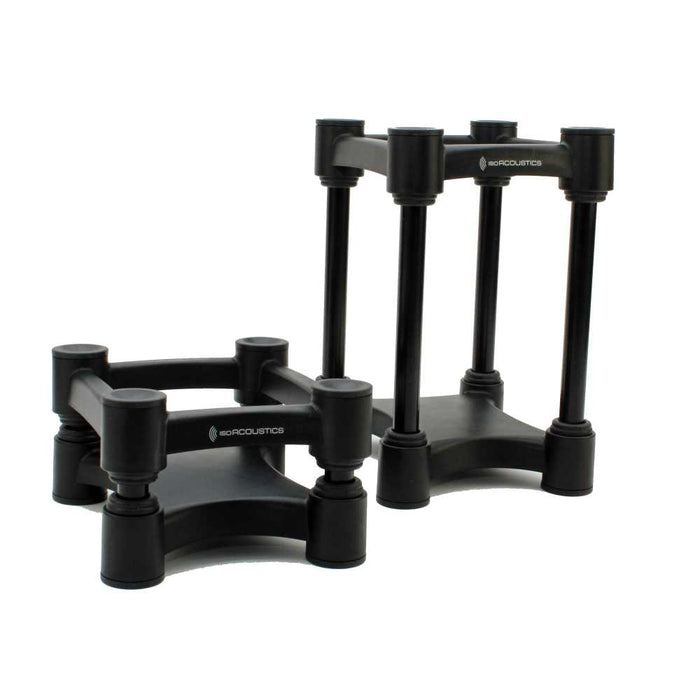
IsoAcoustics L8R130 - Small Isolation Speaker Stands - Pair
IsoAcoustics L8R130 - Small Isolation Speaker Stands
The IsoAcoustics L8R130 are small, fully adjustable isolation speaker stands. Increase monitoring accuracy by reducing vibrations from the speakers, and adjusting the height and tilt of the speakers.
The ISO-L8R130 is the smallest set of stands in the range and can be configured to 3" or 8" in height, with inserts that provide a variety of tilt-up and tilt-down adjustments. In the lowest configuration, the monitor can be tilted down to focus the tweeter to a height below the original supporting surface - providing superior isolation and sound improvement.
Check your monitors against this chart to see which size stands would be best for you:
IsoAcoustic's unique patented design provides superior audio performance by supporting the PIF Principles in acoustic design.
- Placement - proximity to adjacent and nearby surfaces. ISO-L8R audio stands raise the audio speakers or studio monitors off the supporting surface and away from adjacent surfaces to reduce reflections.
- Isolation - from supporting surfaces. Decoupling the audio speakers or studio monitors from the supporting surface reduces the energy from exciting other objects, and allows the speaker and enclosure to float independently.
- Focus - Raising and tilting the audio speakers and studio monitors creates an ideal listening position by forming an equilateral triangle from the speaker to the listener, with tweeters tilted to the listener's exact ear level.
Height Adjustment
An important aspect of the speaker stand design is the ability to adjust the height and tilt angle of the supported speaker enclosure to optimize its position relative to the listener. Two lengths of tubing along with 2 sets of end-plug pairs provide 14 steps of height adjustment as the combinations are used to tilt the speaker up and down. The stand can be assembled and reconfigured repeatedly to establish the ideal position off the supporting surface and focused towards the listener.
In a typical Desktop Audio Workstation (DAW) configuration, the listener is positioned 3 to 4 feet from the monitors with ear level approximately 20" above the work surface. An enclosure containing an 8" speaker may position the high frequency driver 12" from the bottom while an enclosure with a 6" speaker may position the high frequency driver only 8" from the bottom. Raising and tilting these examples to their optimum position can easily be achieved with this speaker stand design. This speaker stand configuration is also suited for applications over longer distances such as in large recording studios or with consumer products where home stereo speakers may ideally need to be raised 6" off the floor and tilted up 8 degrees.
Tilt Adjustment
The tube lengths and end-caps combinations provide a simple means to establish optimal adjustment of large and small monitors over the typical 36 to 48 inch listening distance for mixing and evaluation.
Isolators
ISO-L8R speaker stands prevent the transfer of speaker cabinet energy to surrounding surfaces, effectively isolating the speaker from the desktop, bookshelf or other surface. By allowing the speaker to perform in free space, it's able to sound the way it was intended. The end result is a more accurate, satisfying sound, which makes mixing and listening a better experience.
IsoAcoustic's unique patented design provides superior audio performance by supporting the PIF Principles in acoustic design.
- Placement – proximity to adjacent and nearby surfaces. ISO-L8R audio stands raise the audio speakers or studio monitors off the supporting surface and away from adjacent surfaces to reduce reflections.
- Isolation – from supporting surfaces. Decoupling the audio speakers or studio monitors from the supporting surface reduces the energy from exciting other objects, and allows the speaker and enclosure to float independently.
- Focus – Raising and tilting the audio speakers and studio monitors creates an ideal listening position by forming an equilateral triangle from the speaker to the listener, with tweeters tilted to the listener's exact ear level.
Height Adjustment
An important aspect of the speaker stand design is the ability to adjust the height and tilt angle of the supported speaker enclosure to optimize its position relative to the listener. Two lengths of tubing along with 2 sets of end-plug pairs provide 14 steps of height adjustment as the combinations are used to tilt the speaker up and down. The stand can be assembled and reconfigured repeatedly to establish the ideal position off the supporting surface and focused towards the listener.
In a typical Desktop Audio Workstation (DAW) configuration, the listener is positioned 3 to 4 feet from the monitors with ear level approximately 20" above the work surface. An enclosure containing an 8" speaker may position the high frequency driver 12" from the bottom while an enclosure with a 6" speaker may position the high frequency driver only 8" from the bottom. Raising and tilting these examples to their optimum position can easily be achieved with this speaker stand design. This speaker stand configuration is also suited for applications over longer distances such as in large recording studios or with consumer products where home stereo speakers may ideally need to be raised 6" off the floor and tilted up 8 degrees.
Tilt Adjustment
The tube lengths and end-caps combinations provide a simple means to establish optimal adjustment of large and small monitors over the typical 36 to 48 inch listening distance for mixing and evaluation.
Isolators
ISO-L8R speaker stands prevent the transfer of speaker cabinet energy to surrounding surfaces, effectively isolating the speaker from the desktop, bookshelf or other surface. By allowing the speaker to perform in free space, it's able to sound the way it was intended. The end result is a more accurate, satisfying sound, which makes mixing and listening a better experience.
